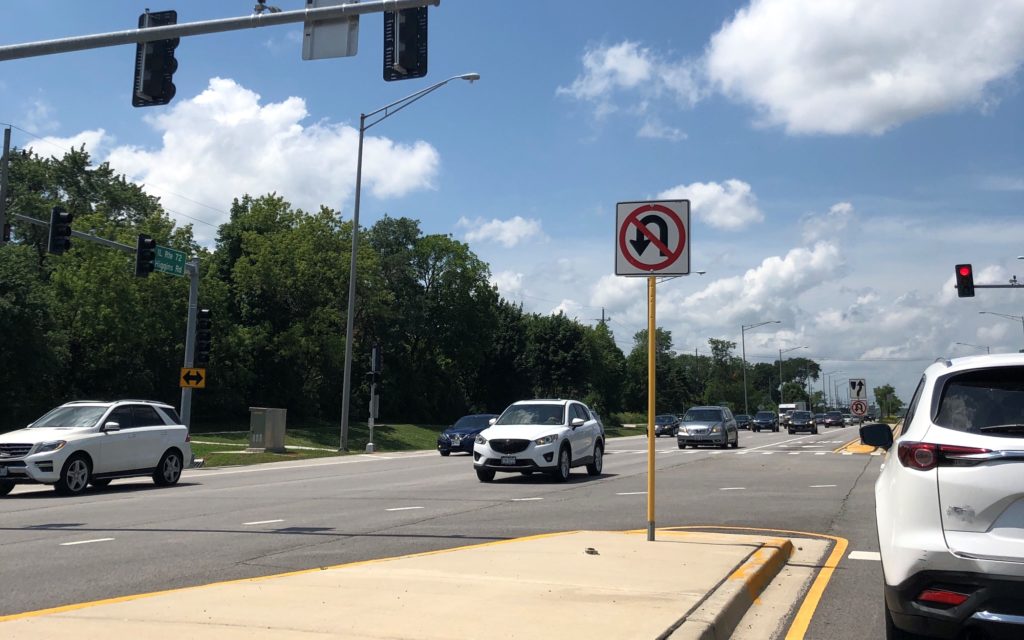
Left hand turns are among the most dangerous maneuvers a driver has to make. Turning left is also inefficient. UPS, the private shipping company, implemented a vehicle routing plan that almost entirely eliminates left turns for its delivery drivers. The company states on its website that cutting out left turns, “will result in a 100,000 metric ton reduction in CO2 emissions, equivalent to taking 21,000 passenger cars off the road.”
UPS says that this strategy saves them millions of dollars in fuel costs every year, too. There is also research that shows avoiding left turns can help regular motorists save on gas. The theory is that left turns cause more idling because drivers often have to wait at intersections before they can turn left safely or for traffic signals to allow them to go.
I know from personal experience that waiting in traffic is frustrating. I know this because I live near Chicago. One of the features of the city’s Northwest Suburbs is multi-lane streets where left turns are only allowed from designated turning lanes and on green arrows. “NO TURN ON RED,” is a sign that I see all over suburban intersections. When traffic is heavy, I end up having to wait two, sometimes even three traffic-light cycles before I am in a position to complete a legal left turn.
That long wait sometimes causes drivers to ignore the red arrow and try to squeeze in a left turn before the drivers that were waiting to go straight from the opposite side in the oncoming lanes start to move forward on their green light. This usually causes a backup because the cars that are trying to go straight are forced to wait while cars have cross in front of them on a red arrow.
This type of turn doesn’t only cause delays. It’s also very dangerous. For example, I was recently stopped at a red light on Higgins Road at an intersection in Schaumburg, IL. Cars from the opposite direction were turning left on a green arrow. Inevitably, maybe because traffic was on the heavier side, some impatient drivers decided they could make their left turn even after their green arrow turned red. As the cars in my lane started moving forward, everyone was forced to stop or slow down to avoid hitting a car that was trying to complete a left turn in front of them. The cars going straight were stopped so as not to hit the driver turning left and the car turning left was moving slowly because some cars, especially in the far-right lanes who may have not seen the person turning left against the light, were passing through the intersection.
What surprised me about this interaction was that the driver of the car turning left was expressing anger-filled gestures at the cars moving forward as she slowly passed in front of them. These were the cars that had a green light. The cars that were going straight on green did have a duty to avoid crashing into the person violating the law and turning left on red if they could, but this person was clearly in the wrong and did not have the right-of-way. This is my personal opinion, but I didn’t see the utility in an avoidable situation for getting angry at people who were following the rules.
There are two easy ways to avoid these kinds of scenarios:
- Don’t turn on red – It’s better to have to wait longer at a light than to risk hurting yourself, someone else, and as a result, damaging property.
- Avoid left turns – Apart from making your commute safer, you might also save money on gas and help the environment by idling less and reducing your car’s emissions.
I do want to add, that some newer cars cut the engine when stopped instead of idling. That technological development may have eliminated the efficiency problem of left turns for some vehicles. However, until we are all traveling in self driving cars, assuming that robots can eliminate all crashes or that they don’t turn against us (I may have watched too many movies), it is still safer to get where you’re going with all right turns where it’s reasonable to do so.
Reader Interactions